The brightest planets in April's night sky: How to see them (and when)
Also, the total solar eclipse on April 8.
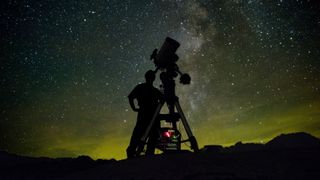
The best planet to seek out during this month is Jupiter, which will be plainly obvious in the west-northwest sky during the first half of April, and then will rapidly fall toward the sun and deeper into the evening twilight during the second half of the month. Mars and Saturn are morning objects and will be within 5-degrees of each other from April 1st through the 17th, and will be closest together on the 10th, when they will be separated by the apparent width of a full moon. Using binoculars, scan low to the east-southeast horizon about an hour before sunrise to pick them up. Since they’ll appear virtually the same brightness with a fine color contrast (Saturn, yellow; Mars, orange) they should appear quite striking.
Brilliant Venus is about to go on a three-month sabbatical, as it will become masked the brilliant glare of the sun during its slow transition from the morning to the evening sky. Meanwhile, little Mercury, coming off an excellent evening apparition in March, will swing back toward the sun and into the morning sky during the second week of April, but don’t expect to see it again until month’s end.
Related: Night sky, April 2024: What you can see tonight [maps]
Read more: Best telescopes for seeing planets in 2024
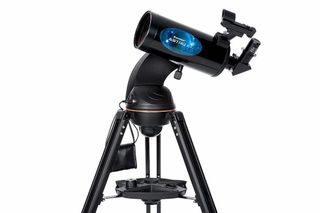
Looking for a telescope to see the planets in August? We recommend the Celestron Astro Fi 102 as the top pick in our best beginner's telescope guide.
In our schedule, remember that when measuring the angular separation between two celestial objects, your clenched fist held at arm's length measures roughly 10 degrees. Here, we present a schedule below which provides some of the best planet viewing times as well directing you as to where to look to see them.
Be sure to check out our best telescopes for viewing planets guide and our more general guides for the best binoculars and the best telescopes. If you're interested in taking your own impressive skywatching images, we have recommendations for the best cameras for astrophotography and the best lenses for astrophotography.
Mercury
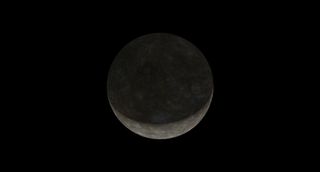
Mercury might be glimpsed on the evening of April 1st with binoculars, low in the west-northwest sky; look about 45 minutes after sunset. Mercury is ending a fine evening apparition that peaked in late March. On April 11th, Mercury arrives at inferior conjunction, positioned between the sun and Earth. It is above the eastern horizon by sunrise in mid-April, but so dim and low for observers at mid-northern latitudes that it’s well-nigh impossible to view even with optical aid. By the end of the month, binoculars may show Mercury (magnitude +1.2) an hour before sunup, near the eastern horizon if the sky conditions are good.
Venus

Venus despite its great brilliance (magnitude -3.9) is buried even deeper in the dawn, making it difficult or impossible to see. It rises less than a half hour before the sun this month and will stay hidden in the sun’s glare for an unusually long time; not until July or August will it emerge very low in the sunset for observers around 40-degrees north. Early on the morning of April 7th finds Venus sitting a few degrees or less to the left of an exceedingly thin (3% illuminated) waning crescent moon.
Mars and Saturn
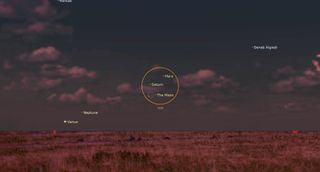
Mars and Saturn lie near to each other in the morning sky and on April 6th, about a half hour before sunrise, use binoculars and scan low near the east-southeast horizon and try to catch sight of thin waning crescent moon – 8% illuminated – with two planets nearby, forming a broad triangle. Saturn (magnitude +1.1) will be situated 2-degrees above the moon, while similarly bright Mars (magnitude +1.2) sits to their upper right; 3-degrees from Saturn and 4-degrees from the moon. Yellowish Saturn, in Aquarius, rises slightly to the south of due east during early predawn twilight at the beginning of April but in late-night darkness at month’s end. By then, you can spot it low and lonely in the east-southeast during dawn. Orange Mars also rises just south of east during morning twilight. It moves from Aquarius into Pisces by the 24th.
Jupiter
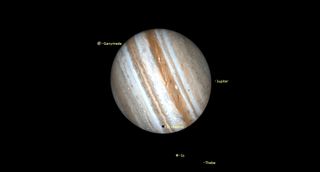
Jupiter moves farther down in the west-northwest sky during April on its way to leaving the evening stage entirely; it sets nearly 3 hours after the sun on April 1st but only 1 hour after the sun on April 30th. In a telescope Jupiter shrinks to just two-thirds of the apparent size compared to when it was at opposition last November. On the evening of April 10th, a half hour after sunset, look low in the west-northwest to see a 7-percent illuminated waxing crescent moon and hovering to its lower left will be Big Jupe.
Solar Eclipse
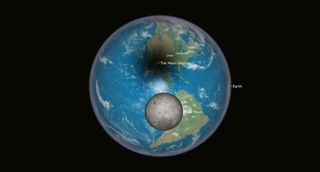
During the April 8th total eclipse, there will be four planets shining in the vicinity of the totally eclipsed sun. Most obvious of the four will be dazzling Venus, which will be positioned 15-degrees to the lower right of the sun. It is quite possible that if you block out the sun with your hand, you could sight Venus as much as 5 to 10 minutes before totality; speck of white against the blue daylight sky. Jupiter will pop into view as totality arrives to the sun’s upper left, at twice the distance from the sun (30-degrees) compared to Venus. Two other planets are considerably dimmer than either Venus and Jupiter, but will be very close to each other. Those will be Mars and Saturn. They’ll be located about 35-degrees to the lower right of the sun and 20-degrees from Venus. Mars and Saturn will be separated by just 1.4-degrees with Saturn (magnitude +1.1) shining a trifle brighter than Mars and appearing to the upper left of the red planet. Their brightness will be close to threshold of objects that will possibly be visible during the total phase of the eclipse. If you insist trying to find them during those precious moments of totality, it would probably be best to scan the sky well to the lower right of the sun and Venus, with binoculars.
Mercury will be situated about 6-degrees above the sun, but shining at only magnitude +4.3 will be difficult, if not impossible to find in the half-light of total eclipse. The same holds true for comet 12P/Pons-Brooks, which is currently approaching the sun and will be positioned about 25-degrees to the upper left of the sun and about 6-degrees to the right of Jupiter. It is not expected to be much brighter than Mercury at magnitude +4.7, and likely will not be evident. Odds are long that this comet will experience a sudden outburst in brightness making it a naked-eye object at totality.
Editor's Note: If you get a great photo of any of the planets and would like to share it with Space.com's readers, send your photo(s), comments, and your name and location to spacephotos@space.com.
Joe Rao serves as an instructor and guest lecturer at New York's Hayden Planetarium. He writes about astronomy for Natural History magazine, the Farmers' Almanac and other publications.
Join our Space Forums to keep talking space on the latest missions, night sky and more! And if you have a news tip, correction or comment, let us know at: community@space.com.
Get the Space.com Newsletter
Breaking space news, the latest updates on rocket launches, skywatching events and more!

Joe Rao is Space.com's skywatching columnist, as well as a veteran meteorologist and eclipse chaser who also serves as an instructor and guest lecturer at New York's Hayden Planetarium. He writes about astronomy for Natural History magazine, the Farmers' Almanac and other publications. Joe is an 8-time Emmy-nominated meteorologist who served the Putnam Valley region of New York for over 21 years. You can find him on Twitter and YouTube tracking lunar and solar eclipses, meteor showers and more. To find out Joe's latest project, visit him on Twitter.
-
rod Good to see in the report Starry Night used for some charts. I use and enjoy very much in my stargazing as well as planet observations and asteroid tracking like 4 Vesta in Cetus now, moving retrograde. In my observation log (MS ACCESS DB), I load up views of the sky from Starry Night into my log entry along with various ephemeris generated that I import into Excel - works very well.Reply
